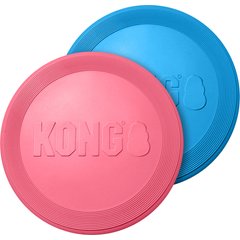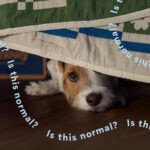7 Best Puppy Toys You Need for Your New Dog
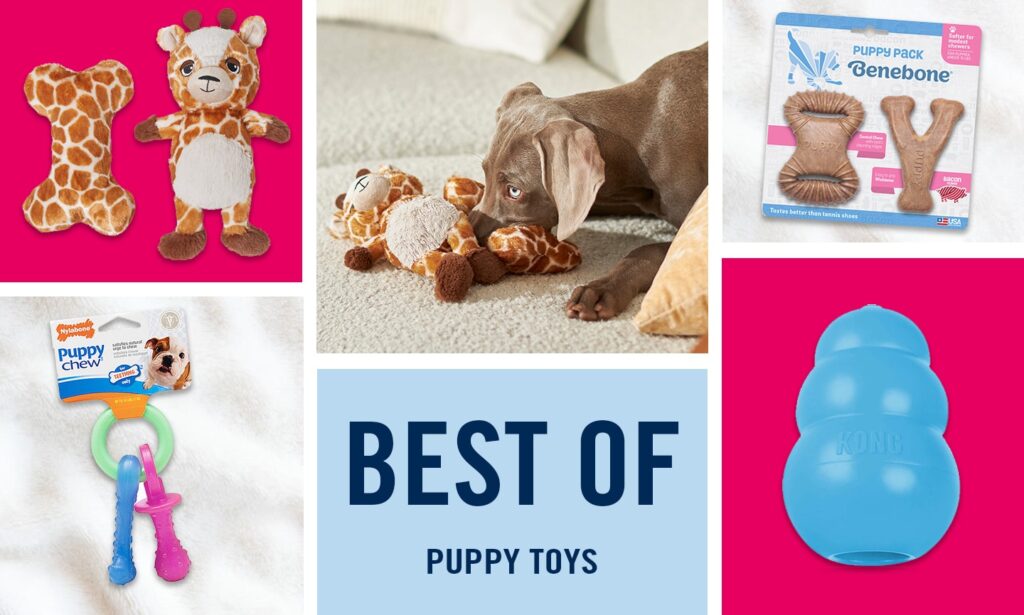
Photo by Sarah Paul
Puppies need lots of playtime—and that means lots of toys. Are all dog toys created equally? Not exactly. Toys are essential for your puppy’s development. The right toys manage behavior, increase mental and physical enrichment, ease anxieties and soothe sore gums during teething.
So, how do you know which puppy toys are perfect–and completely safe–for your new best friend? To help you find the best puppy toy for your new fur baby, we spoke to a veterinarian to narrow down what features to focus on when shopping for dog toys. Plus, we’ve rounded up top-selling, top-rated puppy toys for chewers, fetchers and cuddlers. Designed specifically for puppies at different stages and ages, these customer favorites are a great addition to your puppy’s toy box.
7 Best Puppy Toys
Best Puppy Teething Toy
Nylabone Puppy Pacifier Teething Toy Chew Teething Pacifier Bacon, Small
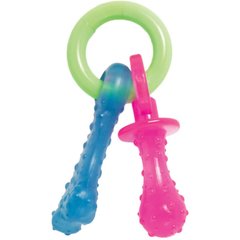
Best Chew Toy for Puppies
Benebone Bacon Flavor Tough Puppy Chew Toy, 2 count
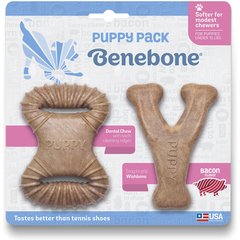
Best Puppy Heartbeat Toy
Snuggle Puppy Original Snuggle Puppy Plush Dog Behavioral Aid Anxiety Relief, Biscuit
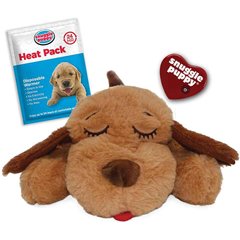
Best Puppy Puzzle Toy
Pixar The Claw & Aliens Hide & Seek Puzzle Plush Squeaky Dog Toy, Small
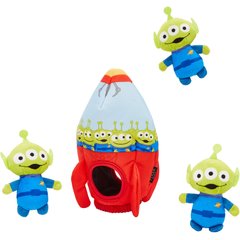
Best Plush Puppy Toy
Frisco Giraffe Plush Squeaky Puppy Toy, Small/Medium, 2 count
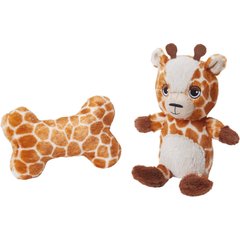
How To Find the Best Toy for Your Puppy
“Toys are critical to a mentally happy dog,” says New Jersey-based veterinarian Dr. Jennifer Feeney, DVM, pet behaviorist and owner of Build a Better Bond Pet Behavior Management. “Your dog’s favorite toy is you, but if you aren’t around, there are lots of things that can keep your pet happy on their own.” Plush, rubber, dental, squeakers—the number of puppy toys on the market is impressively overwhelming. While it’s tempting to gather a collection of the softest and squeakiest toys you can find, buying your new puppy their first toys isn’t so simple if your goal is creating healthy play for both bonding and home alone time.
Before you buy, consider the following:
1. Your Puppy’s Size
If you have a 2-pound Chihuahua puppy, a giant plush toy lobster or a huge ball that they can’t fit in their mouth won’t be useful; your puppy will lose interest quickly. On the other end of the scale, toys that are too small for large dogs are a choking hazard. You’ll want to pick a toy that’s appropriate for their sides: small enough that your puppy can pick them up and move them around, but not too small that they can be swallowed and become a choking hazard, says Dr. Feeney.
2. Your Puppy’s Breed
Certain dog breeds are prone to like certain types of playtime. Herding and working dogs love to run and chase so a fetch toy would be a good pick. Dogs with short, pushed in faces (brachycephalic breeds) like Pugs and Bulldogs are less able to run hard and often prefer to lounge around with a food toy. For mixed breeds and adopted dogs, a pet DNA test kit identifies the dog’s combination of breeds to give insight into your puppy’s tendencies.
3. Your Puppy’s Age
Knowing your puppy’s developmental stage leads you to appropriate toys that your dog will quickly claim as favorites. Teething happens in your puppy’s first year of life, so a teething toy would be ideal for puppies up until they are about 8 months old. Very young puppies (8- to 12- weeks old) sleep for a large portion of the day, so a plush toy to snuggle with would be in order. As your puppy grows, they will be able to run faster, chew harder and play tougher. Enter more durable chew toys and fetch toys. Not certain? Many puppy toys include information on the packaging, such as recommended weight and age. Or, talk to your veterinarian about appropriate toys for your puppy’s age.
4. Your Puppy’s Personality
Observe your dog as they go about their playing, napping and eating-filled day, and after a short time it will become clear what their tendencies are. Knowing whether your puppy prefers to sniff and search out food or run in circles knowing their preferences will help you choose the best toys for your unique pup as they grow.
5. Your Lifestyle
Interactive toys, like flying discs, are great ways to work on your dog’s coordination and to encourage active playtime. But dogs also spend a lot of time alone. Be realistic: If your dog will be spending most of the day by themself while you’re at work, opt for toys that engage your puppy long-term, such as food puzzles, frozen treats for licking and durable chew toys.
Best Overall Puppy Toy
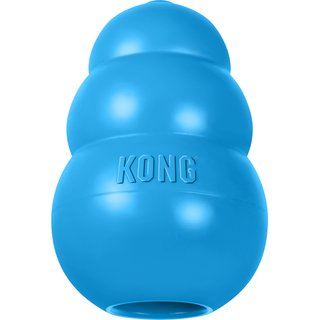
The puppy version of the KONG classic chew toy wins a dental gold star for its gentler rubber that’s safe for puppy teeth and teaches young dogs appropriate chewing behavior. Available in sizes XS to L, it also doubles as a good fetch or chase toy. Customers loved filling the toy with peanut butter or plain yogurt and freezing it for longer lasting and independent playtime.
Best Puppy Teething Toy
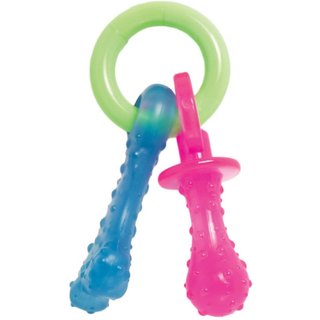
Bright-colors and cute designs attract your puppy (and you!) to this teething toy, but the bacon flavor and nubs that massage and soothe sore gums will keep your dog comfortably gnawing away. Pet parents’ favorite feature was the variety in shape, texture and color that gave their small breed pup chewing options and kept them engaged long-term.
Best Chew Toy for Puppies
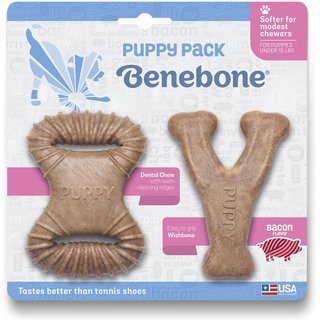
Tough enough for dedicated chewers without damaging their teeth, these bacon-flavored (made with USA-sourced bacon) chew toys are a 4-star alternative to off-limits items in your house (like your shoes). Designed for puppies less than 15 pounds, the wishbone shape is easy to grip so those textured ridges can get to work removing plaque and tartar.
Best Puppy Heartbeat Toy
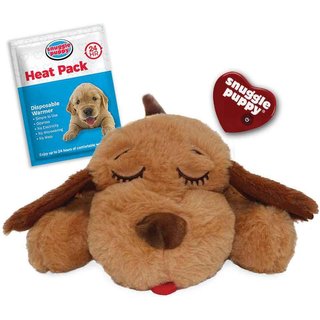
With nearly 1,000, 5-star reviews, this cuddly toy helps soothe the most anxious pups. Soft, warm and with a pulsing heartbeat that mimics their mama’s, this puppy toy calms nervous dogs during crate training and aids in nighttime routines. Customers loved the heating pad feature that mimics a dog’s snuggly body.
Best Puppy Puzzle Toy
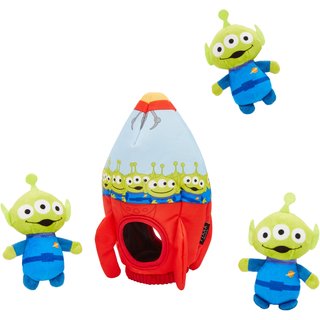
A great non-food puzzle toy that challenges your puppy’s problem solving skills to sniff out the three adorable aliens from their rocketship. Your dog’s reward? Plush squeaker toys that can be stuffed back into the ship for ongoing hide-and-seek fun.
Best Puppy Fetch Toy
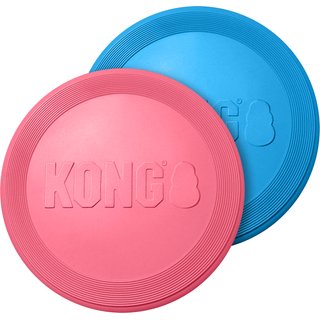
Lots of energy to burn? The flying disc is a favorite among pet parents with its soft, flexible rubber texture that’s appropriate for puppy teeth, but durable enough for a solid fetch session. Designed for puppies 9 months and younger, save this toy for active play sessions and not unsupervised chew time.
Best Plush Puppy Toy
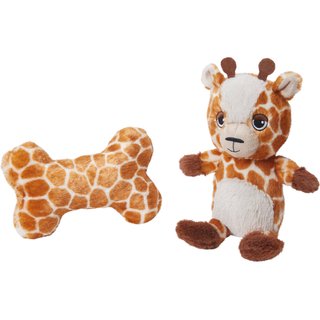
Adorably plush and squeaky, this giraffe and bone combo is ideal for puppy playtime and naptime cuddles, alike. Designed for smaller dog breeds, the 5-star reviews rave that this squeaky toy two-pack is a great first toy option for even the youngest puppies getting used to their new homes.
Safety Tips for Puppy Playtime
Swallowing parts of or whole toys (if too small for your large puppy) is the main safety concern when introducing a new toy. Follow these tips for fun and safe playing:
- Make sure the puppy toy is the right size. Some dog toys come in a range of sizes, and others are designed specifically for small-, medium- or large-breed dogs. Dr. Feeny says to make sure it’s big enough so that they can’t swallow it but not too big that they can’t actually play with it.
- Keep durability in mind when choosing a toy. This is especially important if you have aggressive chewers. “Dogs who love to chew can chew for hours, so make sure you have a strong product that can withstand that kind of activity,” Dr. Feeny says. But you don’t want it to be too tough. Some bones are so hard they can break your dog’s teeth, says Dr. Feeney. They should be soft enough that you can make an indent with your thumbnail.
- Always monitor your puppy during playtime. Never leave your dog unsupervised with toys, especially if they are prone to playing rough or destroying them.
- Keep tabs on the wear and tear. Visually inspect even the most durable toys before play to make sure there are no loose bits that can fall off, no rough or frayed edges or stuffing coming out that could be swallowed and no sharp edges.
How We Chose These Products
Having the right toys for your new puppy makes those first few months of pet parenting less stressful and a lot more fun. We delved through Chewy’s best-selling puppy toys to bring you only the top-rated (at least a 4-star rating) products. These puppy toys are pet-parent approved by hundreds of Chewy customers so you can feel confident in your purchase.
Talk to Your Veterinarian
You and your puppy are just getting to know each other, so if you have any health or dental concerns, check in with your veterinarian for safe toy suggestions based on your puppy’s age, breed and personality.
Next Steps: What More to Expect With Puppy
Now that you’ve conquered playtime with the best puppy toys, find out what else to expect during your puppy’s first year so you can keep your new furry friend happy and healthy .
Best Puppy Toys FAQ
What are the safest puppy toys?
Safe toys for puppies are made with nontoxic ingredients (like natural rubber), appropriately sized and can’t be swallowed whole or ripped apart (stuffing, squeakers and bells can be a choking hazard). Always monitor your puppy whenever they are playing with toys.
What are safe puppy chew toys?
Puppy teeth are more sensitive than adult teeth and can chip if the toy material is too hard. Rubber toys and nylon bones are safer than antler and beef bones, says Dr. Feeney. Chew toys should be durable, but soft enough that you can make an indent with your thumbnail, and made with natural, non-toxic ingredients.
What toys can keep my puppy busy?
Think mental stimulation. Toys that involve searching for food or solving a puzzle to find food can keep dogs occupied for extended periods of time. Dog Puzzle toys or interactive dog toys range in levels and difficulty, starting with a snuffle mat for hiding kibble and progressing to a system where dogs push a lever and open a latch to get a treat. To get your puppy started, fill a KONG Classic toy with dog-safe peanut butter for them to lick out.
What toys are best for an 8-week-old puppy?
Young puppies benefit from teething toys, which should be durable, but not too hard. Some chew toys can be stored in the freezer to numb sore gums, relieving pain. Eight weeks is typically the youngest age a puppy will leave their littermates to join their new home, so behaviorally, it’s go-time for teaching what’s right and wrong. Soft toys and stuffed toys that mimic body heat or their mama’s heartbeat ease anxieties during crate training or home alone time.
Attributions
Expert input provided by Dr. Jennifer Feeney, DVM, UW-AAB, Elite FFCP, LSHC-S, CVF, veterinarian, pet behaviorist and owner of Build A Better Bond Pet Behavior Management in Bridgewater, New Jersey.

